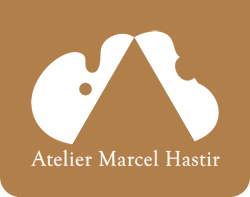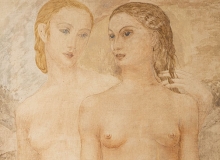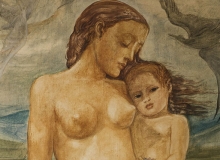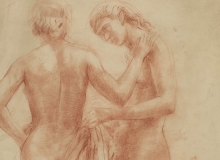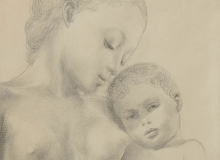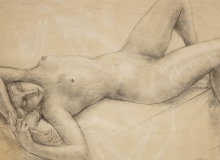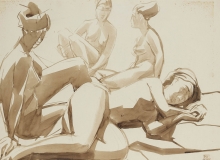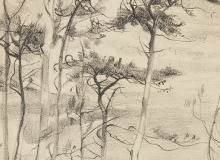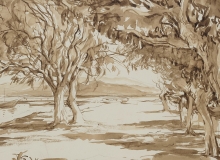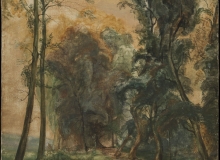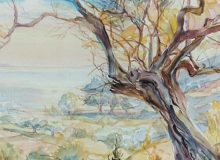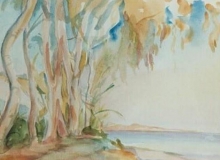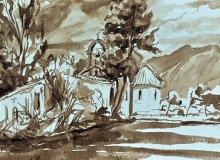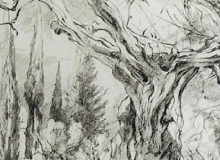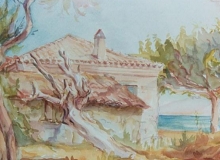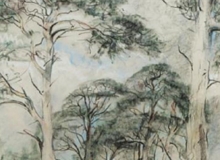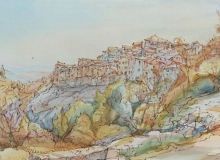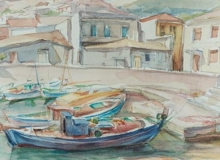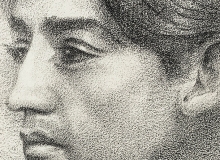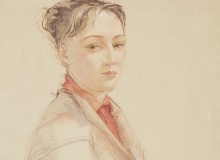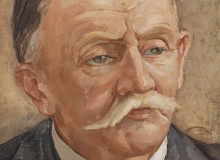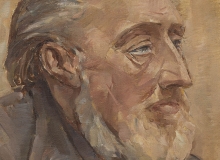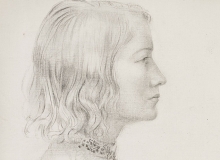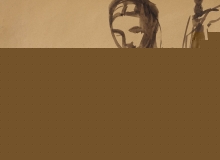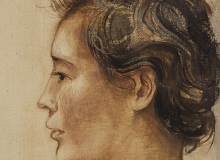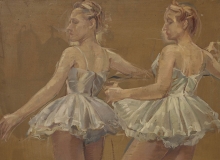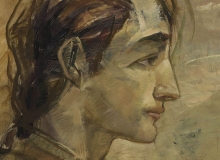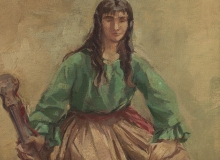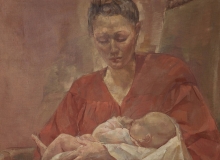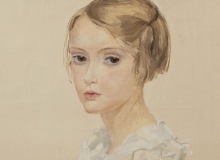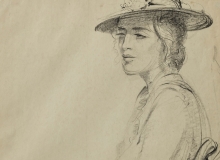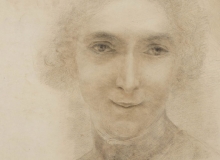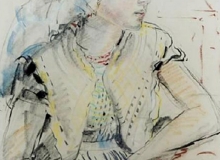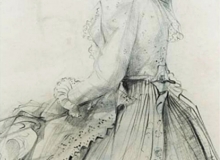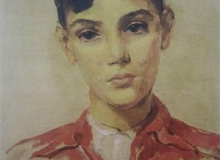A life – an Atelier
Marcel Hastir (1906-2011) was a Brussels-born artist and painter. From 1935 until his death he lived at 51, rue du Commerce, Brussels. This was his studio, and several of his works are still on display there. Apart from his own painting activity, he also taught art, art restoration and worked on the restoration of numerous paintings himself.
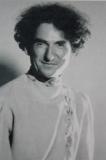 Being of an inquiring mind, as regards the arts as well as philosophy, he turned this studio into an important artistic and cultural magnet in Brussels, by providing a stage for young musicians and dancers and by organising lectures delivered by humanists of the day. This building was also the scene of acts of Resistance during World War II.
Being of an inquiring mind, as regards the arts as well as philosophy, he turned this studio into an important artistic and cultural magnet in Brussels, by providing a stage for young musicians and dancers and by organising lectures delivered by humanists of the day. This building was also the scene of acts of Resistance during World War II.
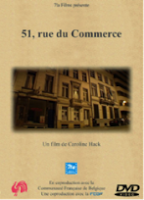
Cover sleeve of the documentary by Caroline Hack
An eventful life, marked by journeys and encounters, which is recounted in Marcel Hastir’s biography “Une Vie”, on sale at the Atelier; and a life illustrated especially vividly in the documentary entitled “51, rue du Commerce” made by the young film-maker Caroline Hack; it has been broadcast on RTBF and the DVD is on sale at the Atelier.
Painter and music-lover
Having graduated from the Brussels Royal Academy for the Fine Arts, Hastir worked as a painter his whole life (essentially as a portrait painter) and gave drawing and painting classes at his studio in rue du Commerce.
But from very early on he made use of the space provided at his studio as a stage for young musicians, from Lola Bobesco to Jacques Brel, not to mention Barbara. Other programmes ranged from chamber music to Negro spirituals.
As he said himself: “Apart from the musical events at the Atelier, I was also asked, in my early rue de Commerce years, to organise a recital by Alfred Cortot at the Ravenstein (…).That was the first of the concerts which I went on to organise in various halls in Brussels” (at the Conservatoire in particular). The archives of these concerts are stored at the Atelier. He was also one of the co-founders of the Stavelot festival, which now forms part of the Festival of Wallonia.
Marcel Hastir founded two prizes, which are to this day still awarded by the Royal Academy of Belgium: the biennial prize for portrait sculpture, and the biennial prize for string quartet composition.
Painter and member of the Resistance
During World War II, in 1941 Hastir managed by subterfuge to obtain permission from the German occupier to set up a “school of drawing and painting” in the Atelier.
But this school was in reality a cover which allowed young people to avoid being sent to Germany as forced labour. It also facilitated contacts between young members of the Resistance.
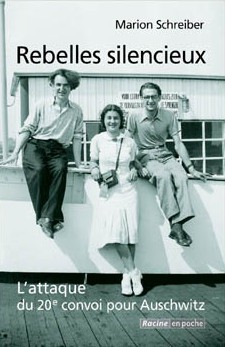
Rebelles silencieux
The attack on the 20th Auschwitz prisoner convoy
By Marion Schreiber
His protegés included brothers Alexandre and Youra Livchitz, and Jean Franklemon. The latter two, plus Robert Maistriau, succeeded on 19 April 1943 in halting the 20th prisoner convoy train from Mechelen to Auschwitz. This unique act of Resistance (described in M Schreibers book Rebelles silencieux (“Silent Rebels”), on sale at the Atelier) enabled several dozen people – among them the young nurse Régine Krochmal – to escape deportation.
During the war years, Marcel Hastir also forged identity papers and allowed anti-Nazi leaflets to be printed on his Roneo machine (see the testimony of Kaja Munz in French).
Although he gained no glory for these selfless actions, what he did during World War II was recognised and honoured by several awards: on his 100th birthday he was declared “Citoyen d’Honneur de la Ville de Bruxelles” and in 2007 he was declared “Mensch of the Year” by the Brussels Jewish Lay Community Centre (CCLJ).
Painter, philosopher and humanist
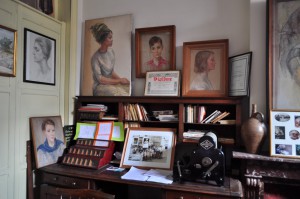
Hastir took an interest in philosophy from an early age. The artist Jean Delville, who set up the Belgian branch of the Theosophical Society, encouraged him to join: indeed it was as a member of that Society that Hastir first took up residence on the 2nd floor of the house at 51 rue du Commerce, since it had shortly before become the Society headquarters.
He attended youth camps at Ommen in the Netherlands before World War II at which lectures were given, notably by Krishnamurti, an intellectual of Indian origin who was at the time an important member of the Theosophical Society.
Hastir invited numerous well-known figures to give talks as part of his cultural programme at the Atelier: Lanza del Vasto, Gandhi’s disciple; Alexandra David-Néel regarding the publication of her book “My Journey to Lhasa” (Voyage d’une Parisienne à Lhassa); Père Pire (= Dominique Pire) were among them. The records of these activities are archived at the Atelier.
A few years before his death, Hastir himself gave a talk entitled “In search of happiness”. In the tumult of the new millennium, the author hands us down a profound and timeless message: “before all else, and over and above form, art consists of the love of life.”
He died in his sleep at 51 rue du Commerce, at dawn on 2 July 2011.
“In bidding farewell to Marcel Hastir, we salute a man whose door, whose ears and whose heart were always open. May the place which housed his creativity and his actions continue to foster this creativity, this generosity and this hospitality!” — These were the closing words of the eulogy delivered by Laurette Onkelinx, deputy Prime Minister, at the funeral in St Michel and St Gudule Cathedral.
He is buried in Ixelles cemetery, in the same vault as his old friend the German writer Carl Sternheim, who died in 1942 and who Marcel Hastir had greatly helped in his final years.
Long live music, long live love, long live life! M Hastir
The works of Marcel Hastir
Below you will find some examples of the work of Marcel Hastir, covering his working years and the fields in which he painted. He concentrated on portraits, nudes and landscapes.
The nudes
The landscapes
The portraits
Marcel Hastir followed the teachings of masters who have since entered the history of Belgian art such as Montald, Fabry, Delville for drawing and painting, Crespin for decorative arts, Rousseau for sculpture, Vauthier (then restorer at the Museum of Ancient Art) for restoration.
This training was enriched by study trips abroad, in particular in Paris and in Italy. He has won artistic prizes, including that of the Monumental Art section of the Academy of Belgium.
If he has always remained in the field of the figurative, we notice in his work Symbolist influences (C. Montald), and some characters who seem to come from paintings by P. Delvaux (P. Delvaux and M. Hastir worked with the same models).
Made with silver tip, pencil, pastel, wash, walnut stain in tempera or oil, his work remains fairly classic and there are many portraits and nudes, in the margin innovations of his time but not unrelated to them.
His works have been exhibited many times in the 1930s in Belgium, notably at the Palais des Beaux-Arts in Brussels alongside Magritte, at the Center Artistique d’Anvers in 1950, at the Galerie Michel Huysmans in Liège in 1971, at the Van Gogh Gallery in Bruges in 1983, in addition to his personal exhibitions in his studio. There were then retrospectives of his work at the Hôtel Charlier and at the Chapel of the Abbey of Stavelot, where we could find his landscapes, his works of Hungarian, Portuguese and Dutch folklore influenced by his travels, and especially his portraits.
In all, probably more than 3000 works; around 300 paintings and at least as many drawings are still in the Atelier in the rue du commerce. Mr. Hastir’s works are also kept in museums, private collections and some of them can be found in the section of old prints of the Royal Library of Brussels as well as in the photo library of the IRPA (Royal Institute of Artistic Heritage).
Many photographs were taken as part of an inventory mission of movable heritage in the Brussels-Capital Region, led by the IRPA and the Directorate of Monuments and Sites. ©KIK-IRPA, Bruxelles.
